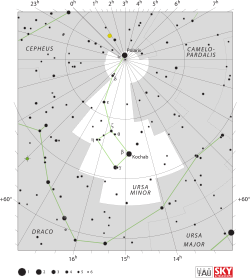Epsilon Ursae Minoris
Appearance
| Observation data ICRS )
| ||
|---|---|---|
| Constellation | Ursa Minor | |
| Right ascension | 16h 45m 58.24168s[1] | |
| Declination | +82° 02′ 14.1233″[1] | |
| Apparent magnitude (V) | +4.19[2] | |
| Characteristics | ||
| Spectral type | G5 III + A8-F0 V[3] | |
| U−B color index | +0.55[4] | |
| B−V color index | +0.89[4] | |
| Variable type | RS CVn[5]
| |
| Absolute magnitude (MV) | −0.922[7] | |
Semi-amplitude (K1)(primary) | 31.8 km/s | |
| Details | ||
| ε UMi A | ||
Rotational velocity (v sin i) | 25.6[3] km/s | |
| Database references | ||
| SIMBAD | data | |
Epsilon Ursae Minoris (ε Ursae Minoris) is a
light years from the Sun. The pair are drawing nearer to the Sun with a radial velocity of −10.57 km/s.[6]

This system forms a
eclipsing binary. The primary eclipse has a minimum of 4.23 in magnitude, while the secondary minimum is magnitude 4.21.[2] This eclipsing behavior was discovered by German astronomer P. Guthnick using observations between 1946 and 1947.[12]
The primary is an
tidal interaction with the secondary.[13]
Epsilon Ursae Minoris has a visual companion: a magnitude 12.32 star at an
arc seconds along a position angle of 2°, as of 2014.[14]
According to R. H. Allen's Star Names, the stars α, β, γ, δ & ε Ursae Minoris were collectively known as Circitores.[15] This led to the name Circitores specifically for ε Ursae Minoris appearing in a 1971 NASA memorandum listing star names.[16]
References
- ^ S2CID 18759600.
- ^ hdl:10995/27061
- ^ S2CID 118450304.
- ^ Bibcode:1978A&AS...34....1N.
- ^ Bibcode:2006ASPC..348..269R.
- ^ S2CID 15290475.
- doi:10.1086/317850.
- ^ S2CID 119387088.
- ^ "eps UMi". SIMBAD. Centre de données astronomiques de Strasbourg. Retrieved 2017-09-14.
{{cite web}}: CS1 maint: postscript (link) - S2CID 14878976.
- ^ "MAST: Barbara A. Mikulski Archive for Space Telescopes". Space Telescope Science Institute. Retrieved 20 December 2022.
- ^ Bibcode:1950PDAO....8..401C.
- Bibcode:2004IAUS..215..144D
- ^ Mason, B. D.; et al. (2008), Washington Visual Double Star Catalog, 2006.5 (WDS), U. S. Naval Observatory, Washington D.C., archived from the original on 2011-02-14, retrieved 2017-09-15.
- ^ Allen, R.H. (1899), Star Names: Their Lore and Meaning, p. 459
- ^ Rhoads, Jack W. (November 15, 1971), Technical Memorandum 33-507-A Reduced Star Catalog Containing 537 Named Stars (PDF), Jet Propulsion Laboratory, California Institute of Technology.
External links
- Kaler, James B., "Epsilon Ursae Minoris", Stars, University of Illinois, retrieved 2017-09-15.
- eps UMi, AAVSO, retrieved 2017-09-15.

